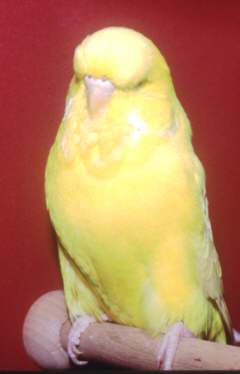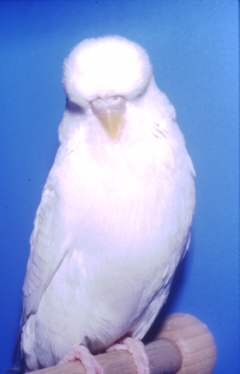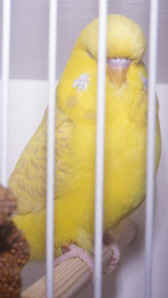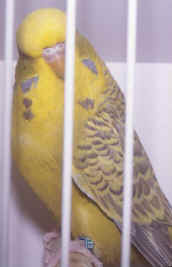REDEYE
BUDGERIGARS
by Ghalib Al-Nasser
ALL budgerigars can be
identified either by their body colour, wing colour pattern, mask colour, feather
orientation, or by the colour of their eyes.
Records
tell us that the first colour to be mutated from the original wild grass green budgerigar
and to be established was the light yellow (Black Eyed Self, as it is called in Australia) in 1872 in Belgium. This was followed by the skyblue in 1881 in Belgium again, but these mutations may have occurred in the Australian bush first
and carried in a hidden form when wild caught green budgerigars were imported into Europe during that period. In fact, it has been
recorded that these yellows were observed in small numbers flying in the wild in Australia among the thousands of light greens.
Other varieties started to appear either by mutation or combination. What I mean by
combination is when two mutations together produce a new variety such as the dark-eyed
clear; a result of combining the two mutations of continental
clearflight with recessive pied. Similar is the appearance of the olive green, achieved by
combining the dark green mutation in a duplicate form, hence the Dark Factor theory. The
boom period of mutation development was in the 1930s.
Some
mutations have disappeared following the evolvement of newer ones; the recessive grey, the
recessive brownwing and the recessive form of lutino and albino have all been superseded.
In
this article I shall concentrate on the budgerigars with red eyes; the sex-linked recessive Ino (lutino & albino),
lacewing and the recessive fallows (English & German).
The Inos (Lutino & Albino)

Lutino
|
Fanciers have always had a
fascination for livestock possessing red eyes, and budgerigar fanciers are no exception.
When the first lutino, a clear yellow bird with a red eye, arrived in the 1870's it caused
a stir but that strain did not last long. One fancier from Great
Britain, who bred the initial lutino mutation at the end of the
19th century and early part of the 20th century, was C.P. Arthur. Again, like most
mutations, an accident or genetical deviation is responsible. Mr. Arthur recalls in his book "Budgerigars and Cockatiels" that he
dropped two eggs, which were covered in excrement from the nest, in boiling water to clean
them and, although not expecting them to hatch, replaced them into the nest. Hatch they
did, and both were clear yellow with red eyes but the mutation was not established.
Hundreds of experimental eggs dipped into hot water did not achieve the desired result in
producing any more lutinos. |

Albino
|
It
looks as if the albino was first to mutate and the lutino followed by the process of
combination. The albino first appeared in 1931 in the aviary of Herr E. Bohm of Bawerk, Vienna. This albino was bred from a pair of
cobalt/whites. This was a hen, the last of a nest of nine chicks. In September 1933 a
further albino hen was bred from a pair of blues by Herr Fischer. This indicated that
those albinos were of the sex-linked variety as, at that time, there was the non-linked
type of the Inos. Soon after the lutino appeared and by the end of the 1940's, the non
sex-linked red-eyed strain started to disappear and in the end ceased to exist.
Breeders
of this variety have an uphill struggle in breeding quality birds while keeping the purity
of colour. With lutinos one needs that rich buttercup yellow body colour as well as size.
And the question is often asked by newcomers as to what is the best pairing to produce the
best lutinos. To increase size one needs to dip in the big normal gene pool. To obtain the
rich buttercup yellow one needs to use the medium and dark factor green birds as the
essence is to avoid any green sheen appearing in the body as well as the cinnamon marking;
two of the undesirable features that some of today's lutinos have. Using grey greens will
dull the colour. With albinos, one needs that snow-white colour, free from any blue
suffusion or cinnamon marking. Again, breeders of albinos will always recommend the use of
greys in normal and opaline forms to increase the size of the albinos and avoid the blue
sheen into the body colour.
The
Budgerigar Society set the colour standards for both varieties together with guidelines
for judges and exhibitors. For the lutino it requires the rich buttercup yellow for the
mask, body colour, frontal, crown and wings while for the albino it is pure white
throughout. The cheek patches for both inos should be silvery white. The B.S. guidelines
set for both judges and exhibitors (Guideline 14 states and I quote – ‘The
following deviations from the standard should be severely penalised: pale
violet colour in cheek patches or cinnamon brown spots or markings on back, wings or tail.
Lutino: there should be no green suffusion throughout. Albino: there should be no blue or
grey suffusion throughout.’
The
B.S. scale of points for all varieties, and the inos are no exception, favours the size of
the bird (including head and spots) and allocates a total of 60 points while the colour
and variety markings will share the remaining 40 points. In the case of the lutino and
albino the clarity and depth of colour is allocated 40 points so it is very important to
breed both varieties to the desired depth of colour by using the best examples in both
varieties.
Nowadays
there is a tremendous following all over the World for the beautiful lutino and to a
lesser degree its counterpart the albino. Both have achieved great heights on the show
bench with BIS awarded to both
varieties all over the country and over many years that I can remember. The Lutino &
Albino Budgerigar Society caters for the needs of those fanciers who breed either or both
varieties, so joining that society is a must.
The Lacewing

Yellow Lacewing
|
The lacewing budgerigar is another mutation that has a similar appearance to
the lutino and albino with the clear body colour of yellow (in the green series) or white
(in the blue series) and having the red eye as well. Perhaps the interest in this variety
is restricted in comparison to the two Ino varieties but still it has its appeal to many,
including myself.
All
the above varieties come from one and the same factor. This has the effect of eliminating
the melanin of the black pigment in the feathers and even the eyes of the bird and
therefore turning the bird from a green (or a blue) to a clear yellow (or white) with that
red eye effect.
Although
the lacewing variety is similar in appearance to that of the lutino and albino, the
marking on cheeks, back of head, neck, wings and tail is of cinnamon brown. The cheek
patches are of pale violet instead of silvery white in the Ino variety and they have well
defined cinnamon brown throat spots. They have fleshy pink feet and the cocks also have a
fleshy pink cere. Eyes are the same as the Inos; red with a white iris ring. |
The
lacewing variety has been bred since 1948 in England. It was recorded that hens appeared in a lutino stud from a light green cock
of unknown history paired to a lutino hen. It seems that these 'badly' marked lutino hens
and their normal brothers were disposed of. The late Cyril Rogers was able to trace and
obtain one of these normal offspring cocks (dark green) and after mating it to a number of
normal hens the lacewing variety was established. Some of those lacewings were exported to
various parts of the world including South Africa where it was further established. Cyril exhibited the first lacewing at the
1951 National Exhibition and in late 1968 the Budgerigar Society standardised the variety.
The late Dr. Alf Robertson of South Africa also bred this variety in 1954 and he believes that the variety established in South
Africa may be not from the stock that Cyril Rogers sent.
The
interest in this variety was revived again in Britain when, on a judging visit, the late
Alf Ormerod and Brian Byles brought back examples of this variety from South Africa and
bred them with a degree of success. The South African strain seemed to have much deeper
and clearer markings and hence the appeal in them was greater. I obtained my initial
lacewing in 1977 from the Byles strain and was reasonably successful with the variety,
prior to my giving up bird keeping in 1979 for 3 years. In 1983 I obtained a quality pair
from the late Alf Ormerod, which started me back with lacewings.
Like
the Ino, the suffusion of green or blue in the body colour is an undesirable fault and
only careful mating should be undertaken to avoid this suffusion.
Another
area to consider is the deep cinnamon brown marking on the wings, mantle etc. There are
two schools of thought on how to achieve that. One encourages the use of cinnamon birds as
partners while the other encourages the use of normals. It can be said that the cinnamon
will dilute the body colour including the wing marking. It is quite apparent that
producing a quality lacewing with the correct marking is not an easy task and here lies
the challenge. My preference is to outcross lacewings to normals only, without introducing
other varieties into the equation.
Having
said that, there has been scientific evidence through the work of Dr. Trevor Daniel in the
early 1980's, stating that the lacewing is in fact a cinnamon Ino. He went about proving
his theory by mating an Ino to a cinnamon and cross-mating youngsters, which eventually
resulted in him producing a lacewing. This is due to the "crossover" of the
genes because the cinnamon gene and the Ino gene are located very close to each other on
the chromosome. However, many lacewing enthusiasts have disagreed with this theory,
believing that the lacewing is a mutation in its own right.
The
variety is sex-linked, like the Ino, and therefore hens cannot be split for lacewing while
cocks can. Hens, because of the sex-linked recessive inheritance genetic theory, can only
be either visual lacewing or non-lacewing.
The
possible pairings with this variety when paired to non-lacewings (let us use the word
"normal" for simplicity) are:
1) Lacewing
cock x Lacewing Hen = 50%
Lacewing cocks and 50% Lacewing hens
2) Lacewing
cock x normal hen = 50%
normal/Lacewing cocks and 50% Lacewing hens
3) Normal cock
x Lacewing hen = 50% normal/Lacewing cocks and 50%
normal hens
4) Normal/Lwing
cock x Lwing hen = 25% Lacewing cocks, 25%
normal/Lacewing cocks, 25% Lacewing hens and 25% normal hens
5) Normal/Lwing cock x normal hen = 25% normal cocks, 25% normal/Lacewing
cocks, 25% Lacewing hens and 25% normal hens
This
way we can easily find out what is the best pairing to produce the lacewing variety in
numbers. It is also of importance to produce the variety to an exhibition standard
regarding the size, shape and deportment of an exhibition Budgerigar combined with the
deep body colour contrast and clarity and depth of the wing marking. A combination that is
not easily achieved, but neither is it impossible. The Amos & Thumwood partnership
achieved great heights with a lacewing yellow cock a few years ago when they won best in
show at a championship show.
Like
the Ino, suffusion of the green or blue in the body colour is an undesirable fault. One
way of ensuring that this suffusion does not occur is the use of the grey factor birds
(greys and grey greens). However, this has the undesirable effect of dulling the body
colour if continually used. The aim is to produce lacewings with deep buttercup yellow and
the use of dark factor birds as breeding partners will go a long way towards achieving
that.
Regardless
of what theory one chooses to accept, the lacewing is a beautiful variety that has its own
place on the show bench. The lacewing needs to be exhibited in the Any Other Colour class
at all shows apart from specialist & rare variety shows where they have their own
class.
For
all lacewing enthusiasts they should join the Rare Variety & Colour Budgerigar Society
that caters for the lacewing as well as other varieties.
The other variety that posses the redeye is the recessive fallow.
The Fallows

English Fallow
|
Three characteristics are associated with this
mutation; red or plum eyes, medium brown wing markings and diluted body colour. The feet
are pinkish grey and the cere in cocks is fleshy pink. All markings on back of head and
neck are of medium brown.
Over the years three different types of this mutation have been
established; the English, German and Scottish fallow. The German fallow differs from the
other two by having a white iris ring around the eye. The Scottish fallow seems to be very
rare. It was found that when pairing the English to the German type, only black-eyed birds
resulted that are split for both types. The German fallow was established in 1929 while
the English was in 1937. It is quite possible that the Australian fallow (with the iris
ring) may have been an indigenous mutation, which resembles the German strain. |

German Fallow
|
Other claims as to the origin of this variety came about in 1931
from correspondence by Mrs. A.R. Hood of California, U.S.A. stating that she had bred from
two pairs of green birds offspring fitting the coloration of the current fallows;
yellowish green, cinnamon wing and tail marking and the deep red eyes.
Logically, Mrs. Hood’s new mutation of birds with red eyes
appearing in 1931 indicates that this mutation is recessive and must have occurred earlier
on a half of a chromosome pair and been passed on to the green birds in the stock. We now
know that when two birds carrying a new recessive colour are paired together then the
actual new coloured bird will appear. This indicates that Mrs. Hood’s new fallows
must have appeared at the earliest in 1929. Sadly this strain was not followed through, as
her initial fallows were sold to other breeders and records were lost.
Other recorded facts of this mutation appeared in 1929 at Herr
Augustin’s of Biel, Switzerland, but the bird did not survive to establish its
kind. Fallow mutations were also bred by Herr Schumann of Magdeburg, Germany, in 1932 and by Herr C. Balser, of Germany at
about the same time. The German mutation was well established and examples arrived in Britain in 1934 to the studs of H.R. Scott, B.S. Campkin, F.G. Simpson
and W.P.C. Unwin.
It is believed that a similar mutation also appeared in Australia as well as South
Africa at about the same period of
time. The Australian strain first appeared in the aviaries of Mr. O’Brian of Newtown, Sydney during the early part of the 1930s. The Australian
mutation was later on established to be the same as that of the German mutation; plum eye
with a white iris ring. This mutation is very popular in Australia and
the best fallows that I have ever seen were those of Ian Hannington at the 1994 Australian
National. They had the desirable size and the beauty of the variety.
The English mutation was established by 1937 in the aviary of F.
Dervan of Luton. That strain first appeared from a normal
green/blue pairing. The late Mr. Arthur Collier recognised that the birds had much
brighter red eyes than the German strain, which was also established in Britain by this time. This new mutation appeared to be showing the same
body/wing markings as that of the German strain but the difference was with the eye
wherein this variety did not have the white iris ring around the plum eye. However,
although the Budgerigar Society Colour Standards description specify that there is no
white iris ring for the English fallow, in reality there is a very faint pink iris and
often some are wrong classed at specialist shows where separate classed for the German and
English fallows are provided, as they are mistaken for German fallows.
Records of the Scottish fallow (red eye without the iris ring)
are not that well documented. However, Ian Whiteside of Cumnock, Ayrshire’s recently
published article in the Scottish Journal traces the story of the Scottish fallow back to
the mid 1920s when the late Jim Moffat’s father came across this beautiful variety in
the aviary of a Mr. Coghill who was a bank manager in Nairn. Mr. Moffat Snr. obtained
examples of this variety from Mr. Coghill and bred with them successfully. Mr. Jim Moffat
carried on breeding those fallows after his father passed away. Mr. Whiteside bred a
fallow in 1986 from a pair of normal greens. On checking records it seems that the
bloodline goes back to Mr. Richie Kerr of Greenock. Both
Richie’s father and Jim’s father were close friends so the story is unfolded
regarding the Scottish fallow. It seems that two fanciers in Scotland have
bred fallows in recent years from Mr. Whiteside’s bloodline. In all cases it seemed
that the Scottish strain had some lethal gene in so far as many of the young do not
survive beyond 3 weeks. So with this information we know that the Scottish fallow still
exists.
The name fallow was initially derived from the German word
“Falben” used initially to distinguish new mutations appearing in Germany. Both the German word “Falben” and the English word
“Fallow” means “uncultivated” which, when applied to budgerigars,
implied that the pigment was uncultivated, or not in its usual finished condition.
The
fallows can be produced in all other varieties but for exhibition purposes I feel that
they should be restricted to the normal varieties. However, for beauty there is nothing to
stop experimental breeders breeding recessive pied fallows or crested fallows for that
matter. The production of the fallow will be like any of the recessive characters which acts as a simple "autosomal recessive gene" and the rules
of their reproduction are as follows:-
1) Fallow X Normal =
100% Normal/Fallow
2)
Fallow X Normal/Fallow = 50% Fallow and 50% Normal/Fallow
3)
Fallow X Fallow = 100% Fallow
4)
Normal/Fallow X Normal/Fallow = 25% Fallow, 50% Normal/Fallow and 25% Normal
5)
Normal/Fallow X Normal = 50% Normal/Fallow and 50% Normal
From
the Table above, it can be deduced that there is absolutely no merit in the pairings
indicated in rules 4 & 5. A lot of wastage
is produced from these pairings and also it is not possible to distinguish the split
fallow progeny from the Normals. However, if fallows of good size are to be produced, then
pairing 4 might just about be the best. If good quality normals are initially used with
fallows as outcrosses to produce the splits as in pairing 1, those quality splits can then
be outcrossed back to fallows to produce quality fallows as in pairing 2 or better still
using 2 splits together (invariably better quality than visual fallows) as in pairing 4 in
the hope that the odd visual fallow produced will be of a better desirable quality.
However, the normal black-eyed birds that are produced from pairing 4 can be either splits
or normals but there are no visual characteristics to distinguish them from each other
without future test pairing.
There
are virtually no short cuts in trying to produce quality fallows apart from using quality
normals as outcrosses, plenty of patience, dedication and luck. The Australian fallow,
over the years, has been produced to such a good standard that I feel our British fanciers
should follow suit. More help and assistance can be given by the Rare Variety & Colour
B.S. to those who wish to breed fallows.
Sadly,
there are not many examples of the variety seen at shows apart from those specialist &
rare variety shows around the country (and the B.S. club show) where separate classes for
both the English & German fallows are available. At all other shows the variety should
be exhibited in the rare variety group catering for the clearbody, fallow, saddleback and
slate and, from the 2006 show season, the rainbows will also be grouped in that section.
Not many fallows are seen at other shows apart from those specialist & rare shows.
The
body colour of the fallow increases in depth of shade progressively downwards from the
upper breast to the rump area where the colour is the deepest. We have seen specimens of
the cinnamon fallows when the cinnamon has been introduced into this variety. The effect
of the cinnamon dilutes the body colour further and in some cases gives the appearance of
a lacewing but with the plum red eye without the iris ring. These birds should be
penalised on the show bench as they do not conform to the B.S. Colour Standards.

Copyright © Ghalib Al-Nasser 2006 all rights reserved.




